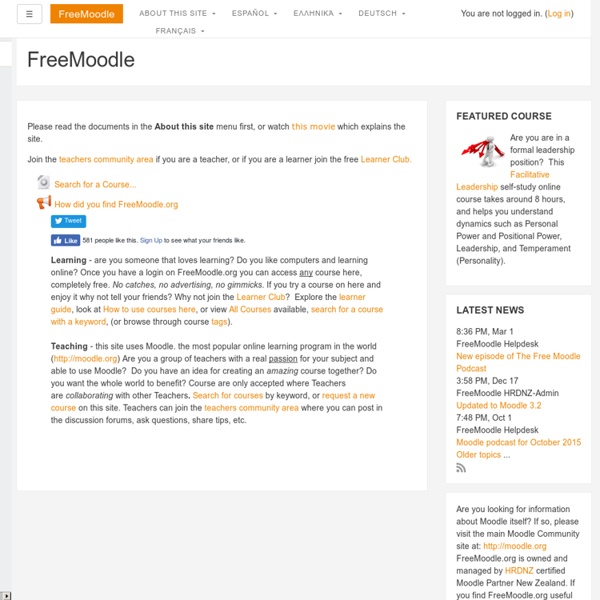



Mount Orange School (Moodle 2.2 Demo) Scoop.its about Moodle Sustainable Urban Gardens MOODLE | Ελληνική Εκπαιδευτική Κοινότητα για το Moodle 14 Καλές Πρακτικές Αξιοποίησης του Moodle στην Τάξη [Παρουσίαση] Πραγματοποιήθηκε το Σάββατο 8 Μαρτίου 2014, στο (ομολογουμένως πανέμορφο) αμφιθέατρο του Βυζαντινού Μουσείου Πολιτισμού, η Ημερίδα με τίτλο «Καινοτόμες Διδακτικές Πρακτικές στη Β/θμια Εκπαίδευση¨, την οποία διοργάνωσαν οι σχολικοί σύμβουλοι Πληροφορικής Ζαχαρίας Μανουσαρίδης και Σοφία Τζελέπη. Η Ημερίδα είχε ως στόχο την ανάδειξη και διάχυση καλών διδακτικών πρακτικών που σχεδιάζονται και υλοποιούνται στις σχολικές τάξεις των σχολείων των Περιφερειακών Ενοτήτων Θεσσαλονίκης και Χαλκιδικής και τις εργασίες της οποίας παρακολούθησαν με μεγάλο ενδιαφέρον πάνω από 120 συνάδερφοι εκπαιδευτικοί Πληροφορικής. Στην Ημερίδα συμμετείχα με 2 παρουσιάσεις, προσπαθώντας να κάνω διάχυση της εμπειρίας μου πάνω σε καλές πρακτικές αξιοποίησης του Moodle στην τάξη καθώς και σε συμβουλές στο πως να δημιουργηθεί ένα Προσωπικό Δίκτυο Μάθησης (PLN) με εργαλεία Web 2.0. Στη συνέχεια μπορείτε να δείτε τη σχετική μου παρουσίαση. Παρουσίαση Φωτογραφίες
Le guide Moodle 2 pour enseignant Le guide Moodle 2 pour enseignant Moodle est une plateforme de formation puissante et vaste. Il est facile pour un enseignant débutant de s'y perdre par tant d'options et de possibilités. Dans le but d'aider les enseignants à mieux choisir l'activité à créer en fonction de l'intention pédagogique, une moodleuse néozélandaise a conçu il y a plus de deux ans un superbe tableau synoptique. Ce tableau, traduit en une douzaine de langue et adapté à différents contextes (voir ce billet), présente sur l'abscisse l'intention pédagogique et sur l'ordonnée les différents modules et activités disponibles dans Moodle. Il s'agit donc d'un excellent outil pour les enseignants désireux d'utiliser Moodle. Nous avons entrepris une adaptation de ce tableau en FGA Montérégie pour la version 2 de Moodle. Plusieurs collègues de la FGA Montérégie ont émis des commentaires et des corrections sur le guide; l'un deux était de créer un tableau plus simple pour l'enseignant débutant.
Sense4Life Guide d'utilisation de Moodle Question de Sébastien Hamel, Service local du RÉCIT, CS des Bois-Francs Savez-vous où trouver un guide de l’utilisation de Moodle à jour qui permettrait d’apprendre à l’utiliser rapidement? Sur le site de Moodle, plusieurs guides ne sont pas créés… Réponses : - Stéphane Lavoie, Service régional du RÉCIT à la FGA, région de la Montérégie Vu la mise à jour maintenant semestrielle de Moodle, la documentation en français peine à suivre le rythme. Cela dit, je donne toujours deux références aux enseignants, outre la documentation de Moodle.org : - Yan Deslongchamps, Service local du RÉCIT, CS des Îles Beaucoup d’informations, vidéos et guides sur ce lien : - Alain Stockless, Service local du RÉCIT, CS des Affluents J’ai fait quelques procéduriers Moodle. J'en profite aussi pour vous faire part de nos développements. De plus, les enseignants ont manifesté l’intérêt d’avoir les parents dans Moodle.
LearningApps.org – Des modules d'e-learning pour votre site Web